How to Achieve Harmony in the Workplace
Achieving harmony in the workplace is crucial for fostering a positive and productive environment. In 2023, understanding and applying Polarity Management can be a game-changer. This guide features insights from top experts in Human Resources, Leadership & Teambuilding, Polarity Management, and Polarity Therapy.
In our fast-paced, problem-solving world, we often look for black-and-white solutions. But in business, sometimes the answer isn’t about solving problems—it’s about managing polarities. Consider these examples:
- Project-oriented or people-oriented
- Feminine leadership or masculine leadership
- Employees’ needs or companies’ needs
- Autocratic leadership or democratic leadership
- Introvert or extrovert
- ENTP or ISFJ
Why choose one over the other when you can embrace both? This guide explores how to leverage polarities to create a harmonious workplace, led by Gen Z’s push for redefined work dynamics.
The tide is shifting once again! In a recent report (September 2022) done by Handshake, Gen Z wants:
- More stability
- Higher salaries
- Better benefits
With so much uncertainty going on between:
- The Massive Tech layoffs (like Google, Amazon, and Microsoft)
- The SVB scandal (that ‘almost’ created a massive hit to the global economy)
Still (and inexplicably) gender bias:
A survey done by Otta showed that women tend to ask for lower salaries than men – and the solution is transparency in job descriptions.’
It’s only normal that Gen Z wants to feel safe and secure. And with the launch of an Effective Workforce Reporting by the CIPD, it’s a start.
Here’s Why You Should Keep Reading
Balancing competing priorities is the tightrope HR professionals walk daily. Picture this: you’re tasked with fostering an innovative culture while simultaneously ensuring stability and consistency. It’s a classic catch-22. This is where polarity management comes into play—a concept that doesn’t seek to solve problems but to leverage the benefits of both sides of a polarity. Whether it’s balancing the need for employee autonomy with organizational control or the push for innovation against the pull of standard operating procedures, polarity management offers a framework to navigate these complexities effectively.
In this complete guide, you’re going to discover all about Polarity Management. You’ll learn why polarity is important in the workplace, how to use polarities to maximise productivity, polarity mapping, polarity coaching, and how to navigate the different polarities in the workplace. You’ll also see polarity management leadership examples, and action steps you can implement… And of course, you will be intrigued by the interviews we had with the prominently featured experts.
Calling out all:
- HR managers
- And L&D managers
Now the question is: how can you embody the best of Polarity Management and achieve harmony in the workplace?
Well, that’s where this complete guide comes into play. You will discover:
- I – What is Polarity Management and Why it is Important in the Workplace
- II – Polarity Thinking, Polarity Mapping, and KPI Polarity
- III – How to Use Polarities to Maximise Productivity and Achieve
- Harmony in the Workplace
- IV – Interviews with the Experts
- V – Polarity Management Inspiration
Part I – What is Polarity Management and Why is It Important in the Workplace
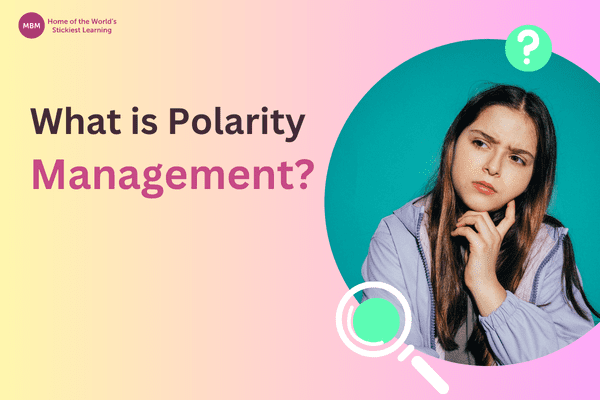
What is Polarity Management?
We first officially “stumbled” on the concept of polarity in our chemistry classes (at least that’s what I found). I had a second epiphany when I was researching my book on masculine and feminine energies.
For as long as we can remember, society separates us and cast us into boxes. And while that has its positives (for example, it promotes creativity), it also has its drawbacks (racism being one).
We were “told” to choose, that choosing will solve the problem (any problem).
Polarity management on the other hand opens you up to other possibilities. Why choose (from a place of fear or lack) when you can have the best of both (from a place of wholeness and abundance)? Because polarity management is about managing two complementary forces on opposite sides and embracing them both.
- Can you choose between inhaling or exhaling?
- Can you choose between women or men?
- Can you choose between your left arm or your right arm?
- Can you choose between HR or Marketing?
- Can you choose between …?
An Important Polarity Principle?
Polarity creates friction, friction creates energy, and this energy leads to growth which keeps the company from being stagnant.
The goal of polarity management is to give you a third choice, to open your consciousness to a complete possibility.
When it comes to polarity, there is no right answer. It’s not black or white. It’s grey.
Let’s look at a Masculine & Feminine Example:
Prior to polarity thinking, we believed that men are/should be masculine, and women are/should be feminine. With polarity management thinking, we understand that people are masculine and feminine from within – they choose when to use the positive of the masculine and the positive of the feminine.
As Dr. Barry Johnson shares in his book;
It’s not a problem to solve, it’s a polarity to manage.”
Why Is Polarity Management Important in the Workplace?
In the world of HR, polarities are everywhere. Take the classic struggle between employee engagement and productivity. We all want employees to be happy and engaged, but we also need them to hit those performance targets. Focusing too much on one can cause the other to suffer. This is where polarity management comes in. Think about your efforts in employee development. You’re constantly balancing the investment in long-term growth with the demand for short-term results. Polarity management doesn’t force you to choose; it shows you how to thrive with both.
Now more than ever it’s time for HR managers to step up. Especially according to a recent survey some of you believe that the end of this turmoil is not yet over.
Did you know that in the UK, one-third of employers still don’t offer parenthood support? This is one factor that increases the ‘feel-good’ bonding between employer/employee, which also leads to higher productivity as the employer is seen as more caring.
Or that 70% of UK employees would love personal development initiatives but only 15% of those employees are voicing it to employers?
We are at a crossroads. Who or what is more important?
- The employer (we don’t have enough budget)?
- The employee (I’m scared of not having the right skills and being laid off)?
- Both? (This is where polarity management comes in).
Professional and personal development is now the only constant employees look forward to. And it’s time to capitalise on it. But for a long time, it’s been done wrong!
A workshop here, and a webinar there are not going to cut it. Personalised programs for each employee are the way forward and Melissa Paris, EMEA regional director of People Science gives three solutions and discusses how development boosts performance.
Investing in employees is no longer a luxury, but it’s become a necessity. But it’s also important to do it with a smart strategy and create a win-win.
Let’s Look at This Example:
A marketing company used to work with designers. But now with MidJourney or RunawayResearch, this company might be tempted to lay off the designers and use those AI apps in order to cut off their budget.
What the employer can do instead is invest in the designers by giving them access to courses and certificates to master those AI tools in order to increase the speed of delivery and have cutting-edge designs.
This way, the employer will leverage the design expertise of the designer, and the designer will gain new skills that will help develop better designs.
The importance of the polarity management model stems from empowering HR managers with a choice. Instead of having to choose between employer or employee, polarity management helps you do just that – manage both in order to optimise performance.
The value of polarity management goes up:
- The more complex the situation becomes
- The more diverse the issue is
- In times of uncertainty and change
- When there is resistance
And we are in the midst of it all.
The Case of Google
To see polarity management in action, let’s look at Google. Known for its innovative culture and high productivity, Google exemplifies how to balance competing priorities effectively.
Google’s challenge has always been maintaining its innovative, open culture while ensuring productivity and efficiency. This tension is particularly evident in its approach to work environments. Google is renowned for its unconventional work environments—colourful offices, open layouts, and unique spaces that encourage creativity. These features attract top talent who thrive on innovation. However, if not managed properly, they could lead to distractions and reduced productivity.
Google uses polarity management to balance these priorities. Larry Page, co-founder of Google, once emphasised, “Innovation is not about saying yes to everything. It’s about saying no to all but the most crucial features.” By fostering an environment that encourages creativity, Google attracts brilliant minds. Employees have the freedom to explore ideas, collaborate, and think outside the box. Simultaneously, they implement rigorous project management practices and performance metrics to ensure that this creativity translates into productive outcomes.
Sundar Pichai, Google’s CEO, acknowledges the balance between data-driven approaches (efficiency) and intuition (innovation). He stated, “We try to use data to inform decisions, but we always make sure we have a healthy dose of instinct and intuition.” Simultaneously, Google implements rigorous project management practices. They set clear objectives using OKRs (Objectives and Key Results) and track performance metrics. This ensures that creativity translates into tangible outcomes.
The results speak for themselves. Google consistently ranks as one of the most innovative companies globally while maintaining high productivity levels. Their approach shows that it’s possible to foster a culture of innovation without sacrificing efficiency. In fact, Google’s ability to manage this polarity has been a key factor in its sustained success.
Lessons Learned from Google’s Success
- Acknowledge the Tension: Marissa Mayer, a former Google executive, believes that “creativity loves constraints.” She adds, “It thrives best when you work within a defined framework.” Google’s workspaces provide freedom within a well-defined system, allowing creativity to flourish.
- Both/And Thinking: Eric Schmidt, another former Google CEO, once said, “We run this company on questions, not answers.” Google’s culture encourages curiosity, exploration, and questioning. It’s a delicate balance—asking questions while maintaining productivity.
- Leadership Alignment: Venture capitalist John Doerr, an early Google investor, highlights the critical role of Objectives and Key Results (OKRs). He states, “OKRs have been critical to Google’s success. They align everyone toward common goals.” Consistent leadership alignment ensures that swings from one pole to the other don’t disrupt the balance.
The Difference Between Solving a Problem & Managing a Polarity
A problem has a definite answer, a simple yes or no would solve it. But a polarity is an ongoing dilemma to be managed.
Problem-solving examples:
- What should we include in our marketing analysis?
- Should we stop working with this client?
- What time should we have the presentation?
Polarity management examples:
- Should we focus on the vision or the day-to-day?
- Should we reduce cost or improve quality?
- Should we focus on the team or the individual?
What about the benefits of polarity management?
The Benefits of Polarity Management
Polarity management has four key benefits:
- Increased productivity
- Improved decision-making
- Enhanced employee engagement
- Reduced conflicts
Let’s move into part II and explore polarity thinking, polarity mapping, and KPI polarity to get a better grasp of how to create a harmonious workplace.
Part II – Polarity Thinking, Polarity Mapping, and KPI Polarity
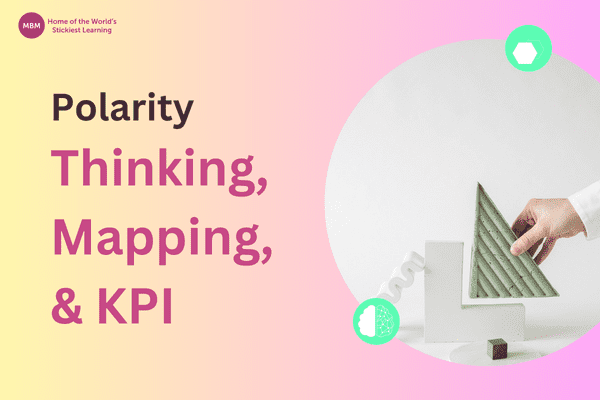
1. Polarity Thinking
Polarity thinking is about thinking in pairs. Looking at both sides and embracing both. It’s about including both polarities instead of having an either/or approach.
Polarity thinking is about increasing the positive and avoiding the downside of each polarity as much as possible. While at the same time monitoring for signs of a shift in the cycle of polarity.
One way to monitor the polarity cycle as we mentioned in a previous section is to have feedback mechanisms such as polarity tools and polarity mapping in place.
Remember the example of breathing in or breathing out. Which are you going to choose?
That’s right, you can’t or else…
When we over-focus on one side of the polarity and avoid the other side, it leads to a disastrous outcome because we are so immersed that we also get the downside of the side we chose. When one side wins, both sides lose. It reminds me of this leadership example (both poles win together or lose together).
Click the image below for a higher resolution.
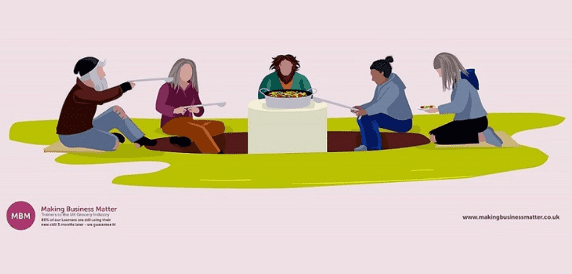
2. What is Polarity Mapping?
Polarity Mapping is helpful in dealing with complex problems in industries and within teams. It is an important technique used to solve team differences, especially with opposing factors trying to make a decision when both alternatives are valid.
While polarity thinking is defined as the way we view problems and polarities, a polarity map is a visual tool, a quadrant, that visually maps down polarity thinking.
The Coaching Process of Polarity Thinking to configure a polarity map:
- Identify a key polarity or a challenge you want to manage.
- Look at and discuss the issues from multiple perspectives.
- Agree on the names of the poles and place each pole on one side of the map – on the top quadrants write the benefits of each polarity and on the bottom quadrants write the downsides of each polarity.
- Brainstorm with the team about the specific ways to achieve the benefits while at the same time preventing as many as possible problems.
- Agree on a higher purpose and deeper fear.
Here is an example of a polarity map (Click the image below for a higher resolution):
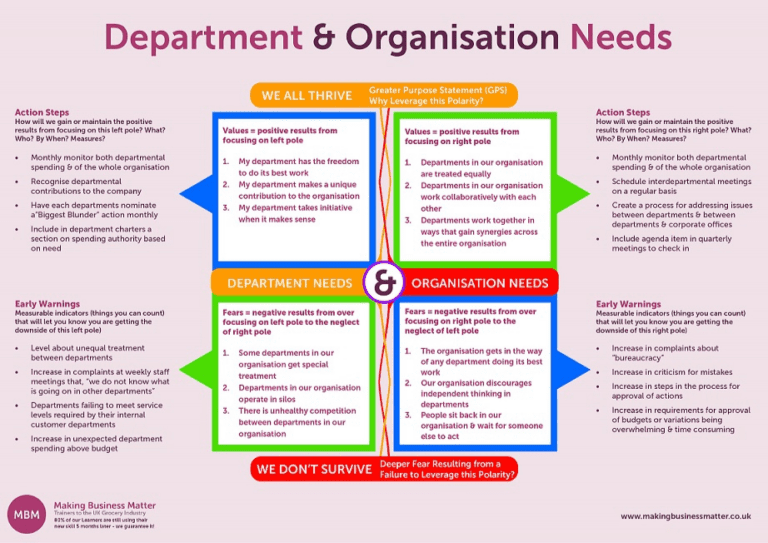
3. What is KPI Polarity?
Key Polarity Indicator (KPI) is a behavioural and mindset model. It’s about observing and acting on the observations. Followed by adjusting and regulating. It’s the monitoring tool we mentioned in the polarity thinking section.
We have two types of KPIs: Human KPIs and Leadership KPIs.
The Human KPI has 3 rings:
- The Aspiration Ring – it’s about 3 results that contribute to fulfilment & success.
- The Capacity Ring – it’s about 6 behaviours required to deliver results.
- The Polarity Ring – it’s about 6 polarities humans have to navigate.
The 6 Human polarities:
- Assuredness & openness
- Focus on self & focus on others
- Hope & reality
- Take seriously & hold lightly
- Desire more & appreciate what is
- Responsibility & forgiveness
When I asked Tim Arnold, leadership and teambuilding expert with organisations such as the United Nations, Siemens, and the Royal Bank of Canada, and author of ‘Lead with And’ about his experience and recommendations on polarities, Tim shared with me:
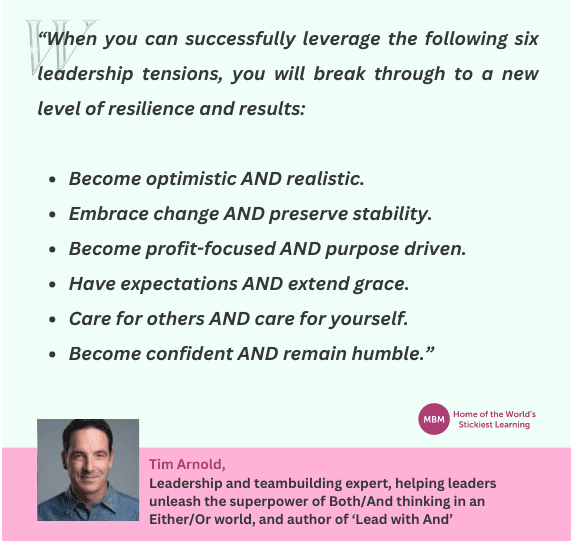
So let’s rise above polarity, let’s unify and embrace conflicting values.
The 6 Key Organisational Polarities:
- Centralised cooperation AND decentralised initiatives
- Reduce cost AND improve quality
- Individual AND team competency
- Continuity AND transformation
- Short-term AND long-term
- Vision AND profit
- Task AND people
- Planning AND flexibility
For example:
In times of change, when a manager chooses to focus on stability instead of change, they only focus on the strength of what is already working and are afraid of the chaos that change brings along. They don’t want to change what is already working.
Here are 4 Powerful tips to manage polarities:
- Listen to the tensions (both verbal and non-verbal).
- Mediate the tension by paraphrasing.
- Map the polarities (for everyone to see the whole picture).
- Support individuals and teams in managing the polarities.
Click the image below for a higher resolution.
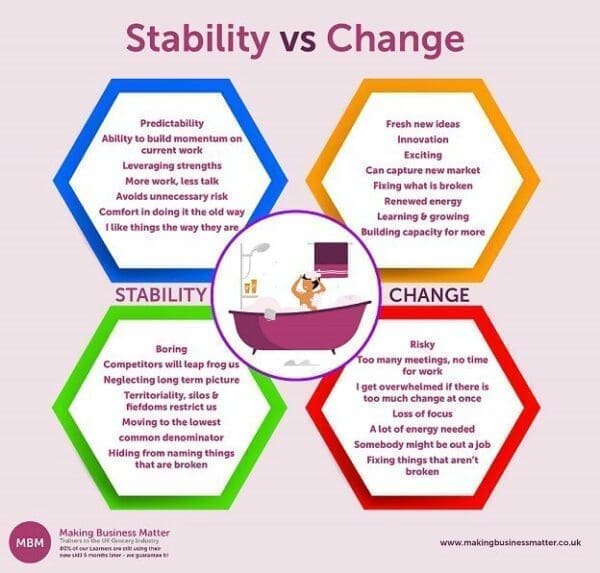
Now that we’ve explored polarity thinking, polarity mapping, and polarity KPIs, let’s see how we can apply them to achieve harmony in the workplace.
PART III – How to Achieve Harmony in the Workplace with Polarity
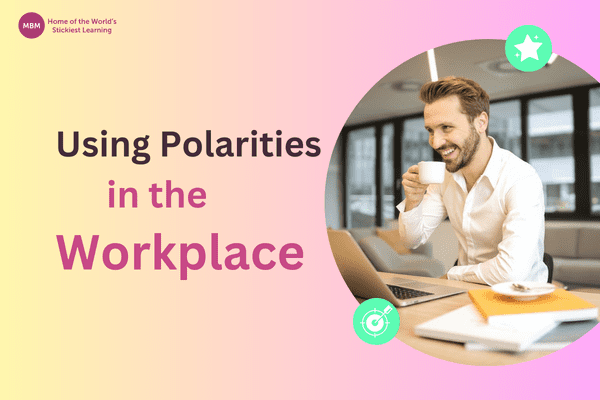
What is a Polarity in Leadership
The best example is what I refer to in my book as masculine leadership and feminine leadership.
For far too long, businesses have led with a dominant masculine leadership style:
- Task or goal-oriented
- Assertive and directive
- Persuasive and competitive
Recently, we started shifting towards a more feminine leadership style:
- People or process-oriented
- Collaborative and inclusive
- Empathetic and intuitive
For example, flexible work and work/life balance are feminine traits, and so are change, growth, and expansion.
To put it into perspective: masculine energy builds a house and feminine energy transforms it into a home.
At the moment we do need a lot of feminine leadership at a societal level. But there will come a point where it will be important to balance both the masculine and feminine leadership styles (at a macro level).
On the business front, both types of leadership are important, and both are strong in their own way. To achieve your goals, you need both.
And polarity can help. Why choose to be task-oriented or people-oriented?
Once you shift your mindset from “what problem do I have to solve?” to “what polarities can I manage?” you change hats from an HR manager to an HR leader.
Leadership is all-inclusive, and management is all-exclusive. A leader embraces all sides, a manager picks a side. A leader focuses on the vision, a manager focuses on the short-term goal.
Leadership and Management Are Two Opposing Poles of the Same Coin
For HR managers to create a harmonious work environment that also leads to efficient results, it’s important to be able to effectively manage different polarities.
It’s what I call: dancing between the micro and macro of managing and leading with polarities.
An important key to remember is that life like business is all about cycles. And similarly, with polarities that also have cycles, each polarity has its own time to shine, and strength to use.
With the recent layoffs and financial crisis as a result of exponential growth…
“Should we focus on the vision for this year?” and continue to focus on the growth of the company?
or
“Should we focus on this month’s targets?” and focus on being efficient and reducing costs and focusing on the growth of employees instead?
By mastering the cycle, you can master the leadership polarities.
How Do We Use Polarity in Everyday Life?
In his book, Dr. Barry Johnson shares a method to manage polarities. His polarity management method involves:
- Seeing
- Mapping
- Assessing
- Learning
- Leveraging
Let’s take choosing between using or not using ChatGPT4 to create a job description as an example and see how the polarity management tool works:
- Seeing: most probably a company with an autocratic leadership style would choose not to use ChatGPT4 (too new, too risky), while a more laissez-faire leadership might choose to go full-on ChatGPT4 mode. But does it have to be one way OR the other?
- Mapping: using or not using ChatGPT4 has benefits and drawbacks. This is where we map the polarities and see both sides.
- Assessing: next, we assess when it’s best to use ChatGPT4 and when it’s best not to use it.
- Learning: now make sure that both poles are respected. Example: when using ChatGPT4 are we taking into consideration the fears of the autocratic leaders (maybe the lack of human connection)?
- Leveraging: action steps to increase the benefits and decrease the drawbacks.
Let’s look at another example:
In your relationship with your partner, do you just take care of your partner, or do you just take care of yourself?
In both scenarios, you are neglecting a party which means one of you will not be happy with the relationship. When you share taking the time to care for both your partner and you, you both win. Sharing is polarity management by excellence.
Communicating with Polarities
When faced with a problem it’s easy to see the solution based on our views and values and based on the context. Each party sees a solution from its own lens and perspective. But it’s only half the answer.
We tend to look at things in black and white. To gain something we fear we’re going to lose something.
When finding a solution that has two opposing values, we fear that gaining a new value will make us lose our old value – and as a result, lose our identity.
The solution? By combining both sides we get a holistic solution.
The best way is to first re-commit to the old value, look at its benefits, and then look at the benefits of the other value. The next step is to prevent the pitfalls:
- Talk about the different perspectives and understand each polarity’s issues.
- Look at the truth from each perspective (in different contexts).
- Look for the connection and how each polarity can leverage the other (interdependence).
Polarity Thinking Risks and Limitations
- Polarity thinking tends to have its limitations when solving complex problems.
- The risks of polarity come in when both parties are stuck in their views.
- With polarities being too far away it can lead to additional conflicts and misunderstandings.
Check out how to spot polarities.
Using Polarity Maps to Achieve Organisational Change

The workforce and workplace are radically evolving, while society and businesses need to adapt to this radical evolution. This change reflects every aspect of innovation and collaboration – embracing it will create economic development opportunities. Watch the video above to hear more from Mr. Pollard.
Polarity Coaching:
When a merger happens, a clash of cultures is bound to happen. New and old employees are bound to have different points of view.
Old employees like stability, and new employees like change.
New employees want to move from the fear of increasing present problems to going after a preferred future they value as the solution to the present problems. It is their point of view and it’s important to understand and leverage this polarity.
Old employees will certainly resist the change and choose stability instead. And it’s also an important point of view as stability is seen as a solution for them. Stability shows as holding to the best of the past and the fear of losing that in the change process.
The Solution?
The 5 steps to move from resistance to embracing change:
1. Seeing: Accept that it’s not about choosing one side or the other, but about looking at both sides.
2. Mapping: Identify the benefits and downsides for each side. It’s easier to see where vulnerabilities lie when interdependent benefits are not considered.
3. Assessing: Once we have all the information laid in front of us, we can assess regularly to make sure we are maximising both benefits and minimising both downsides.
4. Learning: It’s important to look for the lessons. Allow both parties to bring meaning to the assessment results (are values being respected? Are fears being dealt with?).
5. Leveraging: Create action steps based on steps 3 and 4 to make sure to maximise both benefits and monitor warnings to minimise each downside.
Practical Tips for HR Professionals
One of the most effective tools for polarity management is the Polarity Map. This framework helps you visually organise and balance the positive and negative aspects of competing values. Here’s how to use it:
- Identify the Polarity: Determine the two poles you need to manage, such as “Stability” vs. “Change” or “Employee Engagement” vs. “Productivity.”
- Map the Benefits: List the positive outcomes of each pole. For example, stability brings consistency and predictability, while change fosters innovation and growth.
- Map the Downsides: Identify the potential negative consequences of over-focusing on each pole. Too much stability can lead to stagnation, while too much change can cause chaos.
- Balance Points: Find ways to harness the positives of both poles while mitigating their negatives. This creates a dynamic balance that leverages the strengths of each side.
Actionable Steps
Here’s how you can apply these principles in your daily work:
- Conduct Polarity Assessments: Regularly evaluate your organisation’s current focus. Are you clinging to stability like a security blanket and missing out on innovation? Or are you so change-focused that your core operations are getting dizzy? Use surveys, feedback sessions, and performance metrics to get a clear picture.
- Facilitate Team Discussions: Organise workshops and team meetings to discuss these polarities. Use the Polarity Map to visualise the discussion points. Encourage team members to share their perspectives and experiences. This not only builds awareness but also fosters a collaborative approach to managing these tensions.
- Set Balanced Goals: When setting goals, ensure they reflect a balance between competing priorities. For example, if your goal is to boost productivity, include initiatives that also enhance employee engagement. This way, you’re not sacrificing one for the other.
- Monitor and Adjust: Polarity management is an ongoing process. Continuously monitor the outcomes of your strategies and be ready to adjust. If you notice a dip in employee morale due to increased productivity demands, revisit your approach and make necessary changes.
PART IV – Interviews with the Experts
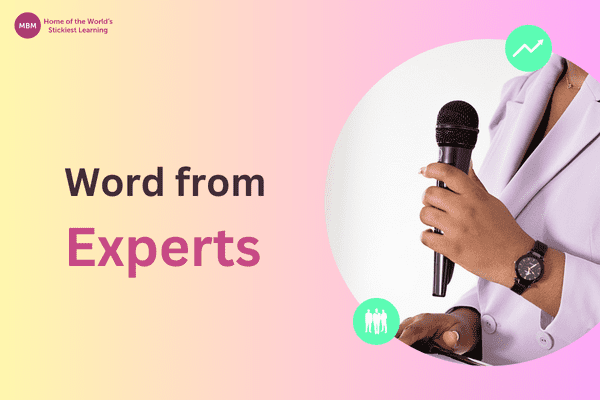
Drum rolls, please!
In this section of the guide, you will get a sneak peek into the minds of some of the best HR, Leadership & Teambuilding, Polarity Management, and Polarity Therapy experts. Let’s start (in no particular order) with:
Polarity Therapy with HR and Polarity Therapy expert Rachel Rider

Rachel has a distinguished career in HR, with her early steps as an HR business partner responsible for developing and coaching leaders and teams at Bloomberg to her specialisation in leadership coaching at AppNexus. Rachel has also extensive experience in meditation, somatic experiencing, and polarity therapy. She is the founder of MettaWorks an elite executive coaching form that focuses on inner work for outer results.
From your time at Bloomberg and AppNexus, what was your main struggle when it came to developing and coaching leaders and teams, and how could Polarity Management and Polarity Therapy help resolve it?
“Polarity Therapy is balancing the energy within a person’s system and reading the energy of others.”
Rachel’s experience has been that the issues that show up at this level are mostly interpersonal. The issues tend to manifest in different ways such as leadership style, communication style, and even the ability to “gain buy-in from your team and stakeholders.”
“This is where polarity therapy can be a very powerful tool. I use this in my work with clients to help them understand themselves and those around them better.”
With Polarity training, you can learn how to read the energy in a room. Even if you can’t see it with your eyes, you can feel it.
“Is someone tense, is someone getting defensive, are you getting defensive, or does it feel really good? Do you have the buy-in of those in the room?”
Polarity therapy helps an individual tune into what is going on with people around them as well as what is going on within themselves.
“When I was working at one of these companies, I had a client who was told he had to work with me because he had such an explosive temper that it was scaring people around him. The company wanted to keep him and coach him because he was also a great achiever: He got things done, and he delivered over and above in all ways. So they really wanted to invest in him. But his behaviour needed to change in order for him to stick around.
When we were working together it was all about him having an understanding of himself. What was it that made him get to that point where he was so explosive with his team? What were the 10,000 steps that led up to that point?
Through our work together we were able to trace it back to that first step before they were at the point of exploding.
That first step is a sense, it’s that tingle in the back of your mind when you’re starting to get upset. It’s the clenching in your jaw that’s indicating frustration. Your explosive behaviour occurs because you haven’t listened to the 10,000 indicators along the way telling you that you are upset. When you explode, it is because you’re long past being able to listen and analyse your frustration, and your frustration has now become in charge of you.
So, our work together with this leader was all about tracking his inner energy, his inner nervous system indicators of ‘ooh, I’m upset right now. What’s going on? What do I need to say? How do I need my voice to be heard in a way that’s constructive at this moment, so I don’t get to that explosive point?’
That’s where working with the inner world was so powerful. He became one of my poster children in the early days of my coaching career because he became this non-explosive, powerful communicator. The organisation came back to me saying, ‘Okay Rachel who else can you work on and how else can we maximise this work?’ It was such a beautiful example of how working on that energy inside has such an impact on how you show up as a leader and your success at your company.”
How can Polarity Management help achieve harmony in the workplace? And how can you use Polarity Management to improve employee engagement and performance management?
“I think that the example that I just talked about is a really nice entryway into talking about harmony in the workplace.”
Awareness of self and awareness of others is key to having a longer fuse and not exploding.
“If someone is self-regulated, they show up differently. For example, say I’ve been working on myself as a leader and one of my employees showed up a little cranky that day. Instead of me reacting, getting defensive, and pointing fingers about the work, I notice, “Oh maybe they’re just having a bad day.” I don’t react to them as I might otherwise and make it about the work. Vice versa, if that employee is working on themselves and comes in cranky, they might even say, “Listen, it was a tough morning for me, please disregard my crankiness. It’s not about the project we’re working on today even though that is feeling overwhelming.”
A great way to shift the energy in a room is by tuning within and communicating our awareness. Transparency also goes a long way to help shift the energy as people feel more connected as a result.
“Harmony is a no-brainer when it comes to energy management internally. What’s remarkable about energy work is that you absolutely will see it show up as an increase in performance. When someone is aware of themselves when someone feels supported by their leaders, supported by their colleagues, and feel like there’s a deeper connection, they show up as their best selves.
So often issues in the workplace that impact success are related to communicating expectations appropriately and allowing the person to have the right tools to be successful. So often that has to do with connecting interpersonally. Energetic work strengthens interpersonal relationships. It has a massive ripple effect in terms of an impact on performance when you do the inner work, when you have an awareness of your energy, when you are aware of someone else’s and you de-personalise it and connect differently.”
Getting to know Rachel – her biggest achievement and her dreams.
Rachel’s biggest achievement is that she feels comfortable talking about the power of her work. Because of the status quo of coaching, she’s been reluctant to talk about it.
“Energetic work can feel like magic to people because you can’t see it concretely. Often, I hear from companies, ‘I don’t know what you’ve done Rachel but wow, this person is different.’ When I would receive this feedback, I wouldn’t come out and say, ‘Oh that’s because we were working on their nervous system and their energy.”
Now, with the consistency of her results and seeing how people are responding to her work, Rachel feels more comfortable talking about it.
“For people to access it and dive into this work, we’ve got to talk about it more. Let’s talk about these unseen forces going on interpersonally. Let’s talk about how powerful it is when you change your reaction. I’m most proud of that right now. It’s internalising the power of this work, owning it, and really starting to talk about it.”
Rachel’s dream is that this work that she’s doing becomes mainstream for leaders and that it travels on the conversation of top leaders.
“How amazing would it be for someone who came out of a disaster of a meeting at work to be asked by their colleagues, ‘What do you think your nervous system was picking up on in the room? When did you notice the energy in the room got bad? What was happening?”
A peek into the future of Leadership with the Author, and Leadership and Strategic Advisor Karin Jironet

Organisation transformations, boardroom dynamics, and individual leadership development – Karin has been a pioneer in assisting leaders to apply spiritual principles in times of transition for over two decades.
Strategic design is at the cornerstone of Karin’s daily practices for leaders in major organisations which helps them develop a higher level of consciousness.
Karin’s unique approach to leaders comes at the right time. With all the big changes and uncertainty, she gives us the opportunity to dive in and open our minds to new ways of leading.
How can feminine leadership create deeper connections between employees as well as clients?
First, here’s how Karin defines feminine leadership, “Feminine Leadership means to lead through relationships rather than through preconceived roles, such as in conventional hierarchies.”
Self-realisation is at the base of leading with relationships. It gives us insights into our personal strengths and weaknesses, and how they show up in our interaction with people and organisational structures.
Following the wise words of Socrates “know thyself,” to do that, the first step is to look within. Karin’s approach stems not only from the rational analysis of knowing ourselves but also and most importantly delving into the “irrational process” or subconscious mind where unexpected parts of our personality show up.
Karin mentioned the following processes which would help unravel those sides:
- Meditation
- Dream analysis
- Active imagination like visualisation
- All forms of creative work
Get ready to be surprised by the insights you might find.
“Your prevailing myth about yourself is not sufficient for personal development which needs confrontation with the unconscious self.”
If you want to build a fuller and deeper connection with yourself, feminine leadership is key. The author of Feminine Leadership: Personal Development Beyond Polarities mentions that this type of connection is a prerequisite to connecting well with employees and clients.
“If you haven’t had the patient interest in yourself, how can you truthfully relate to others with that same patience, compassion, and comprehension?”
Here are some pebbles of wisdom Karin shares with us to better develop our feminine leadership:
- Know when to engage and when to step back.
- Know how to refuse to get triggered.
- Know what to say with the right words.
- Know how to say it with your body language and non-verbal communication.
This creates trust and gives room for employees and clients to share with you with honesty and vulnerability.
How can polarity management help achieve harmony in the workplace? And how can you use polarity management to improve employee engagement and performance management?
“Polarisation is generally considered unwanted and obstructive because it entrenches management processes and stops the flow of interactions. Yet, it’s not uncommon at all because it is an emotional and mental state.”
It is certainly beneficial to bring together groups of opposing views as it creates a sense of belonging and of being right, which makes us feel safe.
However, being stuck on one side of the polarity is not safe at all, but quite the opposite.
“It may reflect pre-conceived and long-held beliefs of oneself and of how things such as culture, power, or gender distribution should look like. And polarisation simply cements these further.”
Karin’s advice on creating a harmonious work environment is to:
- Undo emotional charges by transcending polarities and not by mixing both sides.
- Redesign competition for daily problems.
- Cooperation across business units, with clients, and with competition – which is essential for the renewal of outdated business models. Karin gives the example of Web 3.0 which is all about decentralisation and interaction – a new type of business model.
“The distinction between roles between providers and consumers is becoming more blurred. Harmony through open cooperation improves employee engagement and performance management.”
Getting to know Karin – her biggest achievement and her dreams.
Karin successfully transformed a merger between two culturally different hospitals with very polarised positions. Her four years of labour to integrate “both horizontally and vertically as well as across specialties,” is her proudest achievement.
When I asked Karin about her dreams, she shared her current vision of a healthy and fit lifestyle in the company of her loved ones and the completion of her next book. On the professional front, Karin’s next five years are to guide organisations and individuals “into the future of leadership” with a focus on trust, coexistence, diversity, and relationships.
Karin has a question for you, “How can you harness love and power to be a better leader?”
PART V – Polarity Management Inspiration

Polarity Quotes
“Instead of contradicting each other’s view, the task is to supplement each other’s view in order to see the whole picture. Each of them has key pieces to the puzzle. Paradoxically, opposition becomes resource.” Barry Johnson
“In the industrial world with silo and knowledge scarcity, the majority of people were used to binary thinking with rigid polarity, take the side without deep understanding.” Digital Master
“To avoid polarity or thinking extremely, you have to practice multi-dimensional thinking processes such as critical thinking, creative thinking, systems thinking, analytical thinking, synthetic thinking, holistic thinking and more.” Digital Master
“Already at sixteen, my mind was a battlefield: my love of pagan beauty, the male nude, at war with my religious faith. A polarity of themes and forms: one spiritual, the other earthly.”
Michelangelo
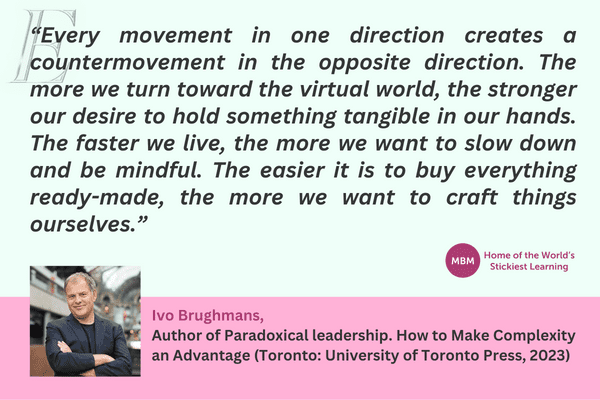
“Male and female are the first things we learn because they represent the polarity of existence.” Frederick Lenz
“People desire to separate their worlds into polarities of dark and light, ugly and beautiful, good and evil, right and wrong, inside and outside. Polarities serve us in our learning and growth, but as souls we are all.” Joy Page
“If you take a strong stance and have a clear opinion or statement on any subject online, you’re going to polarise people. And without that polarity, there’s no discussion. Discussion is what I want, which means that I’m fine with the consequences.” Tim Ferriss
“Angels and demons were identical–interchangeable archetypes–all a matter of polarity. The guardian angel who conquered your enemy in battle was perceived by your enemy as a demon destroyer.” Dan Brown
Polarity Management Example in Action
Let’s look at the before and after of polarity thinking – Employee Needs and Employer Needs.
Before polarity thinking – An employee is struggling with a task and is always late for delivery. Coming from the employee lens, they want to deliver the best work possible, even if they are late, after all, quality comes first.
From the employer’s view, however, they are frustrated because the employee always delivers late to the client and it’s affecting the relationship. The employer keeps sending reminders, but nothing seems to help. The employee meanwhile is frustrated because they just want to deliver the best work without being micromanaged.
After polarity thinking – the employer and employee met to discuss the upsides and downsides of employee focus and employer focus. It was very interesting for them to learn each other’s perspectives. Until working on polarities and seeing the results, neither was aware of time, negative energy, and a decrease in productivity that the either/or thinking took.
The employer offered the employee to take a course to develop their set and process to make him or her accomplish his or her task faster. The employee was thrilled and very appreciative of the moral and financial support of the employer especially because they cared about their development and growth. With a better process, less distraction, and renewed motivation, the employee finished faster.
Once the employer and employee mapped the benefits and downsides of both of their respective needs and set a plan of action to leverage both needs while keeping in check warning signs, they were well on their way.
Key pointers to Become a Better Polarity Manager
- Master polarity management theory.
- Create polarity maps to manage problems.
- Use polarity coaching – Integrate polarity management and mapping in your coaching. Also, use tools such as The Leadership Circle 360 Profile (TLCP) which reflect polarity management.
Take your Polarity Management to the next level
It’s time to rethink your hiring process and employee relationships.
While it’s great to hire for diversity, hiring diversity just for the sake of it or to ‘look good’ affects your bottom line.
Remember how we mentioned at the beginning of the article how Gen Z is asking for new and better contracts? Despite the growing demand for talent, unemployment in the UK is still high (approximately 10 million). There is a big rift between what companies are offering and what employees want. This is pushing a lot of people to find alternative choices.
You can start by building a more transparent approach with prospective employees. Build a more equal relationship with them.
- Too many applications? Find a way to limit the numbers, set strict rules of acceptance and focus on the quality, and once you get a certain manageable number, stop accepting applications. Overcome your FOMO.
- Still reluctant to put the salary or at least a range in the job description? You’re asking interviewees to be vulnerable, why don’t you lead by example?
So, as your company’s HR or L&D leader, are you adapting to changes? Massive changes are on the horizon, we’ve barely scratched the surface.
Become the best HR and L&D leader in the UK by joining our training program and discovering how we make training stick and remember to lead with action.
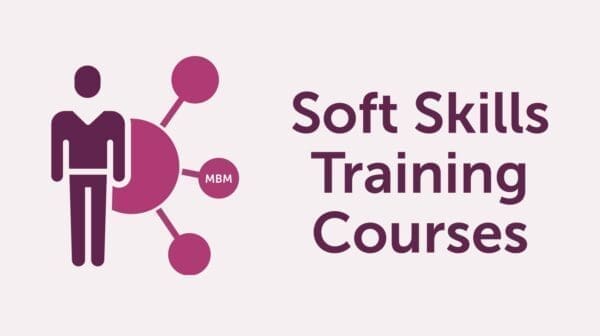
What’s Next?
Now that you know how to manage polarities and create harmony in your workplace, let us help you step truly embody polarities with an action plan.
We at Making Business Matter strongly support personal and professional growth. As an HR manager or L&D manager working in the UK, we want to help you by giving you an action plan specially created for HR and L&D managers working in the UK. Also, in our training, you will learn about work-based activities, receive a roadmap for line managers to support their teams, and our 5-level evaluation (chain of evidence) to show the ROI of our training (they stick!).
>> 📥 DOWNLOAD NOW: FREE GUIDES FOR HR MANAGERS AND TRAINING OFFICERS <<
Conclusion
In this complete guide, you discovered what is polarity management, why polarity management is important for the workplace, polarity thinking, polarity mapping, KPI polarity, how to use polarities to maximise productivity, interviews with the experts, and the polarity management inspiration.
In part I you found out about polarity management, why polarity management is important for the workplace, and the benefits of polarity management.
Then in part II, you discovered polarity thinking, polarity mapping, and KPI polarity.
In part III we discovered polarity in leadership, how we use polarity in everyday life, communicating with polarities, polarity thinking risks and limitations, and using polarity maps to achieve organisational change.
Thereafter, in part IV you uncovered polarity therapy with Rachel Rider and the role of feminine leadership and polarity with Karin Jironet.
In part V you discovered polarity management quotes, an example of polarity management in action, key pointers to becoming a better polarity manager, and how to take your polarity management to the next level.
Send us a message on LinkedIn, and we’ll send you tools, processes, and strategies on how to best cope with today’s changing work landscape (no fluff, only making business matter).
Attention: Subscribe through LinkedIn to know when we publish a new article.




